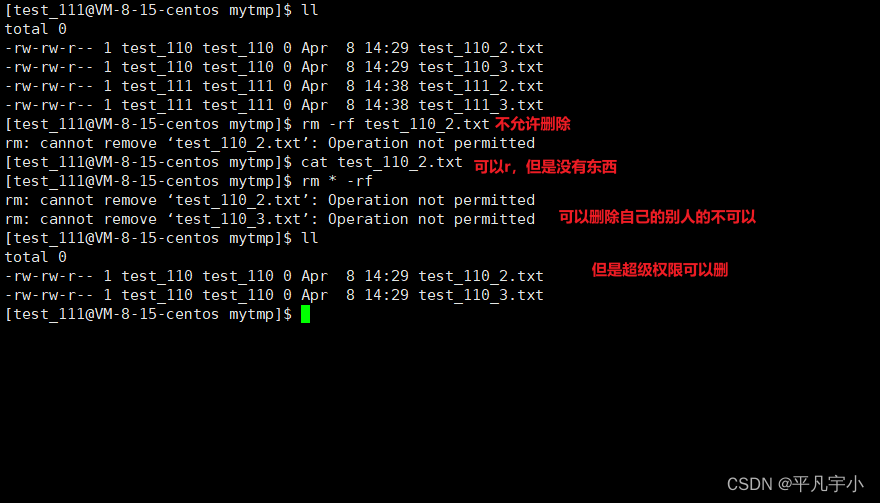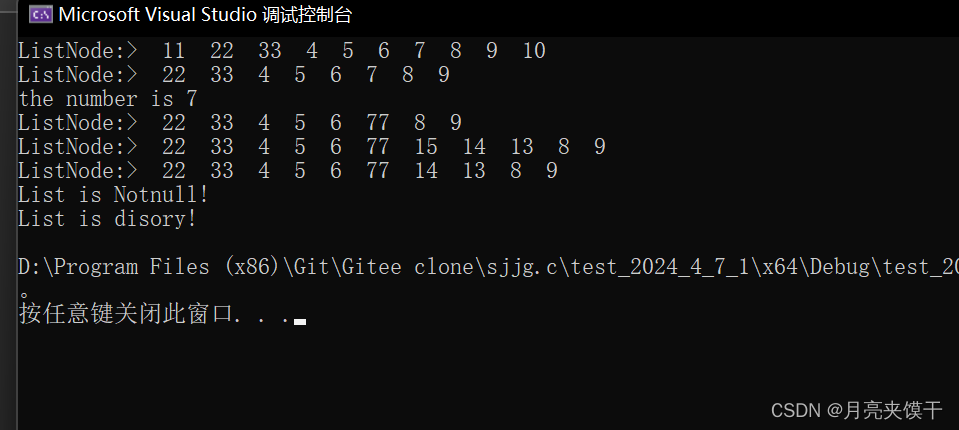一、什么是双向链表
1、定义
双向链表也叫双链表,是链表的一种,它的每个数据结点中都有两个指针,分别指向直接后继和直接前驱。所以,从双向链表中的任意一个结点开始,都可以很方便地访问它的前驱结点和后继结点。
双向链表的结构如图(图片来源于网络):
2、时空复杂度
双向链表的空间复杂度是 O ( n ) O(n) O(n) 的,其时间复杂度如下:
| 操作 | 时间复杂度 |
|---|---|
| 遍历 | O ( n ) O(n) O(n) |
| 访问指定节点 | O ( 1 ) O(1) O(1) |
| 删除指定编号节点 | O ( n ) O(n) O(n) |
| 删除指定位置节点 | O ( 1 ) O(1) O(1) |
| 在指定编号的节点后插入节点 | O ( n ) O(n) O(n) |
| 在指定位置的节点后插入节点 | O ( 1 ) O(1) O(1) |
| 查询前驱、后继 | O ( 1 ) O(1) O(1) |
| 修改指定编号节点的值 | O ( n ) O(n) O(n) |
| 修改指定位置节点的值 | O ( 1 ) O(1) O(1) |
| 交换两个 list 容器 | O ( 1 ) O(1) O(1) |
二、双向链表的基本操作
1. 定义双向链表节点
每个节点有三个值:
val:存储每个节点的权值;last:指向每个节点的前面的第一个节点;next:指向每个节点的后面的第一个节点;
代码如下:
template<typename T>
struct ListNode{T value;ListNode<T>* last;ListNode<T>* next;ListNode():value(0){last=NULL,next=NULL;}ListNode(const T &x):value(x){last=NULL,next=NULL;}~ListNode(){value=0;delete last;delete next;}
};
2. 创建双向链表类
类里面包含两个节点和一个变量:
headnode:头节点,初始时前驱后继均为空,值为 − 1 -1 −1;endnode:尾节点,初始时前驱后继均为空,值为 − 1 -1 −1;listsize:记录双向链表的节点个数,不包含头尾节点;
代码如下:
template<typename T>
class list{private:unsigned listsize;ListNode<T>* headnode;ListNode<T>* endnode;
};
3. 初始化双向链表类
共有四种初始化方式:
list<类型名> a;:此时创建一个空的双向链表;list<类型名> a(n);:此时创建一个大小为 n n n 的双向链表,并将所有点的初始值赋为 0 0 0;list<类型名> a(n,m):此时创建一个大小为 n n n 的双向链表,并将所有点的初始值赋为 m m m;list<类型名> a={a1,a2,a3,...,an};:此时创建一个大小为 n n n 的双向链表,并将第 i i i 个节点的初始值赋为 a i a_i ai;
第一种初始化方式代码如下:
list():listsize(0){headnode=new ListNode<T>(-1);endnode=new ListNode<T>(-1);
}
第二种初始化方式代码如下:
list(const int &size_t):listsize(size_t) {headnode=new ListNode<T>(-1);endnode=new ListNode<T>(-1);ListNode<T>* now=headnode;for(int i=0;i<listsize;++i){ListNode<T>* newnode=new ListNode<T>(0);endnode->last=newnode;newnode->next=endnode;newnode->last=now;now->next=newnode;now=now->next;}
}
第三种初始化方式代码如下:
list(const int &size_t,const int &val
):listsize(size_t){headnode=new ListNode<T>(-1);endnode=new ListNode<T>(-1);ListNode<T>* now=headnode;for(int i=0;i<listsize;++i){ListNode<T>* newnode=new ListNode<T>(val);endnode->last=newnode;newnode->next=endnode;newnode->last=now;now->next=newnode;now=now->next;}
}
第四种初始化方式代码如下:
typedef std::initializer_list<T> lisval;
list(lisval vals){listsize=0;headnode=new ListNode<T>(-1);endnode=new ListNode<T>(-1);ListNode<T>* now=headnode;for(auto val:vals){ListNode<T>* newnode=new ListNode<T>(val);endnode->last=newnode;newnode->next=endnode;newnode->last=now;now->next=newnode;now=now->next; ++listsize;}
}
3. 一些基础的函数
这些函数是除了加点删点之外最常见的几个函数。
-
size():获取链表的大小,返回一个 unsigned 值,表示当前链表中普通节点(非头尾节点)的个数。代码如下:
unsigned size() const {return listsize; } -
empty():返回当前链表是否为空,如果是,返回 true,否则返回 false。代码如下:
bool empty() const {return listsize==0; } -
begin():返回第一个普通节点。代码如下:
ListNode<T>* begin( ) const {return headnode->next; } -
end():返回尾指针。代码如下:
ListNode<T>* end( ) const {return endnode; } -
rbegin():返回最后一个普通节点。代码如下:
ListNode<T>* rbegin( ) const {return endnode->last; } -
rend():返回头指针。代码如下:
ListNode<T>* rend( ) const {return headnode; } -
front():返回第一个普通节点的值。代码如下:
T front() const {return begin()->value; } -
back():返回最后一个普通节点的值。代码如下:
T back() const {return rbegin()->value; } -
print():遍历并输出链表中每个普通节点的值,结尾换行。代码如下:
void print( ) const {if(empty()) return;ListNode<T>* now=headnode->next;while(now->next!=NULL){printf("%d ",now->value);now=now->next;} putchar('\n'); } -
swap(list<类型名> &b):交换两个 list 容器,实际上是交换头尾指针和 l i s t s i z e listsize listsize。代码如下:
void swap(list<T> &b){ListNode<T>* temp;temp=headnode;headnode=b.headnode;b.headnode=temp;temp=endnode;endnode=b.endnode;b.endnode=temp;unsigned size_t=listsize;listsize=b.listsize;b.listsize=size_t; }
5. 插入节点
共四种方法,代码如下:
void push_back(const T &val
){ ++listsize;if(endnode->last==NULL){ListNode<T>* newnode=new ListNode<T>(val);endnode->last=newnode;newnode->next=endnode;headnode->next=newnode;newnode->last=headnode;return;}ListNode<T>* pre=endnode->last;ListNode<T>* newnode=new ListNode<T>(val);pre->next=newnode;newnode->last=pre;newnode->next=endnode;endnode->last=newnode;
}
void push_front(const T &val
){ ++listsize;if(headnode->next==NULL){ListNode<T>* newnode=new ListNode<T>(val);endnode->last=newnode;newnode->next=endnode;headnode->next=newnode;newnode->last=headnode;return;}ListNode<T>* suf=headnode->next;ListNode<T>* newnode=new ListNode<T>(val);headnode->next=newnode;newnode->last=headnode;newnode->next=suf;suf->last=newnode;
}
void insert(const T &pos,const T &val
){ int nowpos=0;if(pos==0){push_front(val);++listsize; return;} else if(pos>=listsize){push_back(val);++listsize; return;}ListNode<T>* now=headnode->next;while(now->next!=NULL){++nowpos;if(nowpos==pos){ListNode<T>* newnode=new ListNode<T>(val);ListNode<T>* suf=now->next;newnode->next=suf;suf->last=newnode;newnode->last=now;now->next=newnode;++listsize; return;}now=now->next;}
}
void insert(ListNode<T>* now,const T &val
){if(now==endnode){push_back(val); return;}ListNode<T>* newnode=new ListNode<T>(val);ListNode<T>* suf=now->next;newnode->next=suf;suf->last=newnode;newnode->last=now;now->next=newnode;++listsize; return;
}
6. 修改指定位置的值
两种方法,代码如下:
void reassign(const T &pos,const T &val
){if(pos>listsize) return;if(empty()||!pos) return;ListNode<T>* now=headnode->next;int nowpos=0;while(now->next!=NULL){++nowpos;if(nowpos==pos){now->value=val;return;} now=now->next;}
}
void reassign(ListNode<T>* now,const int &val
) const {now->value=val;
}
7.删除节点
和插入一样,共有四种,代码如下:
void pop_back(){if(empty()) return;ListNode<T>* now=endnode->last;ListNode<T>* pre=now->last;if(pre==headnode){endnode->last=NULL;headnode->last=NULL;--listsize; return;}endnode->last=pre;pre->next=endnode;--listsize;
}
void pop_front(){if(empty()) return;ListNode<T>* now=headnode->next;ListNode<T>* suf=now->next;if(suf==endnode){endnode->last=NULL;headnode->last=NULL;--listsize; return;}headnode->next=suf;suf->last=headnode;--listsize;
}
void erase(const int &pos
) {if(pos>listsize) return;if(empty()||!pos) return;ListNode<T>* now=headnode->next;int nowpos=0;while(now!=endnode){++nowpos;if(nowpos==pos){ListNode<T>* pre=now->last;ListNode<T>* suf=now->next;if(pre==headnode||suf==endnode){endnode->last=NULL;headnode->next=NULL;delete now;--listsize; return;}pre->next=suf;suf->last=pre;delete now;--listsize; return;}now=now->next;}
}
void erase(ListNode<T>* now
){ if(now==headnode) return;if(now==endnode) return;if(empty()) return;ListNode<T>* pre=now->last;ListNode<T>* suf=now->next;if(pre==headnode||suf==endnode){endnode->last=NULL;headnode->last=NULL;--listsize; return;}pre->next=suf;suf->last=pre;--listsize; return;
}
8. 注销双向链表类
遍历一遍,然后将每个节点都删除就可以了。
代码如下:
~list(){ListNode<T>* now=headnode->next;while(now!=NULL){ListNode<T>* nxt=now->next;delete now;now=nxt;} delete headnode; listsize=0;
}
三、完整代码
我知道你们只看这个
码风丑陋,不喜勿喷
#include<stdio.h>
#include<stdlib.h>
#include<initializer_list>
namespace STL{template<typename T>struct ListNode{T value;ListNode<T>* last;ListNode<T>* next;ListNode():value({}){last=NULL,next=NULL;}ListNode(const T &x):value(x){last=NULL,next=NULL;}~ListNode(){// value={};last=NULL;next=NULL;}};template<typename T>class list{private:unsigned listsize;ListNode<T>* headnode;ListNode<T>* endnode;public:list():listsize(0){headnode=new ListNode<T>(T({-1}));endnode=new ListNode<T>(T({-1}));}list(const int &size_t):listsize(size_t) {headnode=new ListNode<T>(-1);endnode=new ListNode<T>(-1);ListNode<T>* now=headnode;for(int i=0;i<listsize;++i){ListNode<T>* newnode=new ListNode<T>(0);endnode->last=newnode;newnode->next=endnode;newnode->last=now;now->next=newnode;now=now->next;}}list(const int &size_t,const int &val):listsize(size_t){headnode=new ListNode<T>(-1);endnode=new ListNode<T>(-1);ListNode<T>* now=headnode;for(int i=0;i<listsize;++i){ListNode<T>* newnode=new ListNode<T>(val);endnode->last=newnode;newnode->next=endnode;newnode->last=now;now->next=newnode;now=now->next;}}typedef std::initializer_list<T> lisval;list(lisval vals){listsize=0;headnode=new ListNode<T>(-1);endnode=new ListNode<T>(-1);ListNode<T>* now=headnode;for(auto val:vals){ListNode<T>* newnode=new ListNode<T>(val);endnode->last=newnode;newnode->next=endnode;newnode->last=now;now->next=newnode;now=now->next; ++listsize;}}unsigned size() const {return listsize;}bool empty() const {return listsize==0;}ListNode<T>* begin() const {return headnode->next;}ListNode<T>* end() const {return endnode;}ListNode<T>* rbegin() const {return endnode->last;}ListNode<T>* rend() const {return headnode;}T front() const {return begin()->value;}T back() const {return rbegin()->value;}void print() const {if(empty()) return;ListNode<T>* now=headnode->next;while(now->next!=NULL){printf("%lld ",now->value);now=now->next;} putchar('\n');}void push_back(const T &val){ ++listsize;if(endnode->last==NULL){ListNode<T>* newnode=new ListNode<T>(val);endnode->last=newnode;newnode->next=endnode;headnode->next=newnode;newnode->last=headnode;return;}ListNode<T>* pre=endnode->last;ListNode<T>* newnode=new ListNode<T>(val);pre->next=newnode;newnode->last=pre;newnode->next=endnode;endnode->last=newnode;}void push_front(const T &val){ ++listsize;if(headnode->next==NULL){ListNode<T>* newnode=new ListNode<T>(val);endnode->last=newnode;newnode->next=endnode;headnode->next=newnode;newnode->last=headnode;return;}ListNode<T>* suf=headnode->next;ListNode<T>* newnode=new ListNode<T>(val);headnode->next=newnode;newnode->last=headnode;newnode->next=suf;suf->last=newnode;}void insert(const T &pos,const T &val){ int nowpos=0;if(pos==0){push_front(val);++listsize; return;} else if(pos>=listsize){push_back(val);++listsize; return;}ListNode<T>* now=headnode->next;while(now->next!=NULL){++nowpos;if(nowpos==pos){ListNode<T>* newnode=new ListNode<T>(val);ListNode<T>* suf=now->next;newnode->next=suf;suf->last=newnode;newnode->last=now;now->next=newnode;++listsize; return;}now=now->next;}}void insert(ListNode<T>* now,const T &val){if(now==endnode){push_back(val); return;}ListNode<T>* newnode=new ListNode<T>(val);ListNode<T>* suf=now->next;newnode->next=suf;suf->last=newnode;newnode->last=now;now->next=newnode;++listsize; return;}void reassign(const T &pos,const T &val){if(pos>listsize) return;if(empty()||!pos) return;ListNode<T>* now=headnode->next;int nowpos=0;while(now->next!=NULL){++nowpos;if(nowpos==pos){now->value=val;return;} now=now->next;}}void reassign(ListNode<T>* now,const int &val) const {now->value=val;}void pop_back(){if(empty()) return;ListNode<T>* now=endnode->last;ListNode<T>* pre=now->last;if(pre==headnode){endnode->last=NULL;headnode->next=NULL;delete now;--listsize; return;}endnode->last=pre;pre->next=endnode;delete now;--listsize;}void pop_front(){if(empty()) return;ListNode<T>* now=headnode->next;ListNode<T>* suf=now->next;if(suf==endnode){endnode->last=NULL;headnode->next=NULL;delete now;--listsize; return;}headnode->next=suf;suf->last=headnode;delete now;--listsize;}void erase(const int &pos) {if(pos>listsize) return;if(empty()||!pos) return;ListNode<T>* now=headnode->next;int nowpos=0;while(now!=endnode){++nowpos;if(nowpos==pos){ListNode<T>* pre=now->last;ListNode<T>* suf=now->next;if(pre==headnode||suf==endnode){endnode->last=NULL;headnode->next=NULL;delete now;--listsize; return;}pre->next=suf;suf->last=pre;delete now;--listsize; return;}now=now->next;}}void erase(ListNode<T>* now){ if(now==headnode) return;if(now==endnode) return;if(empty()) return;ListNode<T>* pre=now->last;ListNode<T>* suf=now->next;if(pre==headnode||suf==endnode){endnode->last=NULL;headnode->last=NULL;delete now;--listsize; return;}pre->next=suf;suf->last=pre;delete now;--listsize; return;}void swap(list<T> &b){ListNode<T>* temp;temp=headnode;headnode=b.headnode;b.headnode=temp;temp=endnode;endnode=b.endnode;b.endnode=temp;unsigned size_t=listsize;listsize=b.listsize;b.listsize=size_t;}~list(){ListNode<T>* now=headnode->next;while(now!=NULL){ListNode<T>* nxt=now->next;delete now;now=nxt;} delete headnode;listsize=0;}};
}
using STL::list;signed main(){system("pause");
}
给个赞再走吧











